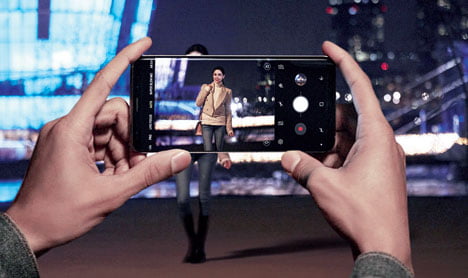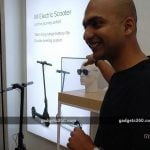
Mobile World Congress 2018 clearly belonged to Samsung. On the company’s latest flagship, the Galaxy S9 and S9+, the familiar all-screen design remains but the camera has been reinvented completely and that will set new benchmarks for the mobile industry.
The Galaxy S9+ comes with more memory and storage compared to the smaller S9, and it also has a dual-camera system, which includes a telephoto camera. But it is the wide-angle camera fitted to both models that marks the biggest change. The 12-megapixel camera has the first variable aperture fitted to a smartphone. This means you can switch between an f-stop of 1.5 for low-light photography and an f-stop of 2.4 for shooting outdoors. It’s about replicating what the human eye can do automatically.


The other features of the phone that place Samsung’s new offerings above the iPhone X are:
1 The 5.8-inch screen on the S9 is the same as the iPhone X screen but it comes minus the notch (thank god!). The S9+ has a larger 6.2-inch screen. In fact, the S9 screen has been awarded DisplayMate’s (which analyses screen quality across smartphones, televisions and other products) Best Performing Smartphone Display Award and its “highest ever A+ grade”. According to DisplayMate, the Galaxy S9’s colour accuracy is “visually indistinguishable from perfect”.
2 The phones have stereo speakers and they’re tuned by AKG and have a Dolby Atmos codec which offers richer, louder sound.
3 The phones have the fingerprint scanner on the back of the phone. This is such a big relief when compared with the iPhone X, which relies on FaceID. Yet, both companies offer facial-recognition features but the technology used is different. While the iPhone X has a True Depth (depth-sensing) camera on the front of the phone to map out your face in 3D using infrared dots, the Galaxy S9 and S9+ use Intelligent Scan, a combination of the iris scanner and the less-secure facial recognition feature that uses the non-depth sensing front camera to unlock.
4 The AR emojis on Samsung are better than Apple’s animojis, as these look realistic and they capture your facial expressions.
5 The S9 offers onboard storage up to 256GB and up to 400GB of expandable storage. The iPhone X only offers a 64GB and 256GB option with no SD card slot.
6 The headphone jack is still around, which translates into good marketing for the Korean company.
7 The phone’s new snapper allows 960 fps slow motion, which is better than the iPhone’s 240fps slow motion.
8 DeX, a system that lets you work your Galaxy smartphone as a desktop computer. This means a lot to enterprise users.
In India, the phones will be officially announced on March 6 and will go on sale on March 16.
BACK TO SCHOOL
The three new Chromebooks from Lenovo sure can take a beating at the hand of its users… school students. Focused on the school-going crowd, the 100e ($219), 300e ($279) and 500e ($349) Chromebook can withstand most damages that a third-grader can think of. They come with rubber bumpers and liquid resistant keyboard, which make them somewhat drop- and splash-resistant. While the 100e and 500e are powered by Intel Celeron processor, the 300e comes with MediaTek chipset. The viewing angle is better on the 300e and 500e but the best aspect of the 300e is that you can write on the screen with a pencil without damaging the tempered glass screen, while the 500e has its own electro-magnetic resonance pen which makes note-taking easy. Our favourite? The 500e.











